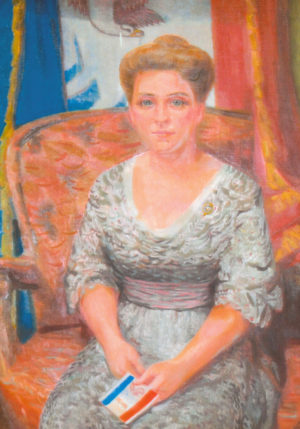
Dixie Cornell Gebhardt is credited for having helped create Iowa’s flag 100 years ago. In 1956, Drake University art professor Leonard Good painted this posthumous portrait of Gebhardt at the request of the Iowa Daughters of the American Revolution. It currently hangs in the Iowa Governor’s Formal Office. Photo courtesy of State Historical Society of Iowa
By Leo E. Landis
“At last, Iowa has a state flag, thanks to the D.A.R.” So read the caption in the Des Moines Register of May 11, 1917. The newspaper bore an image of the proposed flag with credit given to Dixie Cornell Gebhardt of Knoxville and other Iowa members of the Daughters of the American Revolution (D.A.R.). The debate for a state flag began in the late 1800s, but Iowa was among the final states to select a design. It was a decision argued in newspapers and became the cause of a legislative commission, but not until Gebhardt’s proposal and the national excitement over World War I did the effort gain statewide support. Even after the May debut, Gebhardt’s effort to have the flags produced and issued to Iowa-connected troops proved nettlesome.
Gebhardt’s background did not necessarily prepare her for the position as Iowa’s flag designer. Born in 1866, the daughter of Dr. Norman and Mary Cornell, she graduated from Knoxville High School and also attended a girl’s academy operated by Catholic nuns. In 1900, she married George Tullis Gephardt. The couple divorced in 1904 and Dixie never remarried. Like many socially-conscious women she joined philanthropic groups including the P.E.O. and attended the Presbyterian Church. She lived the majority of her life in Knoxville.
Iowa’s reluctance to establish a state flag dated to the period following the Civil War. Many northern states reacted against the states that seceded as their citizens elevated their state’s interest in slavery over the nation. Thus the movement to create a state flag received critiques through the 1880s into the 1900s. On July 11, 1889, the Emmet County Republican of Estherville reprinted an account of the dedication of the Georgia capitol that stated that the U.S. flag was not flown on the new building, but the Georgia flag was. The story reported that you would have never seen such an affront to the national flag “in Wisconsin or Iowa or Kansas.” Of course it would not have happened in Iowa as no state flag had been created.
TO READ MORE ABOUT THIS STORY AND OTHER FASCINATING STORIES ABOUT IOWA HISTORY, subscribe to Iowa History Journal. You can also purchase back issues at the store.
